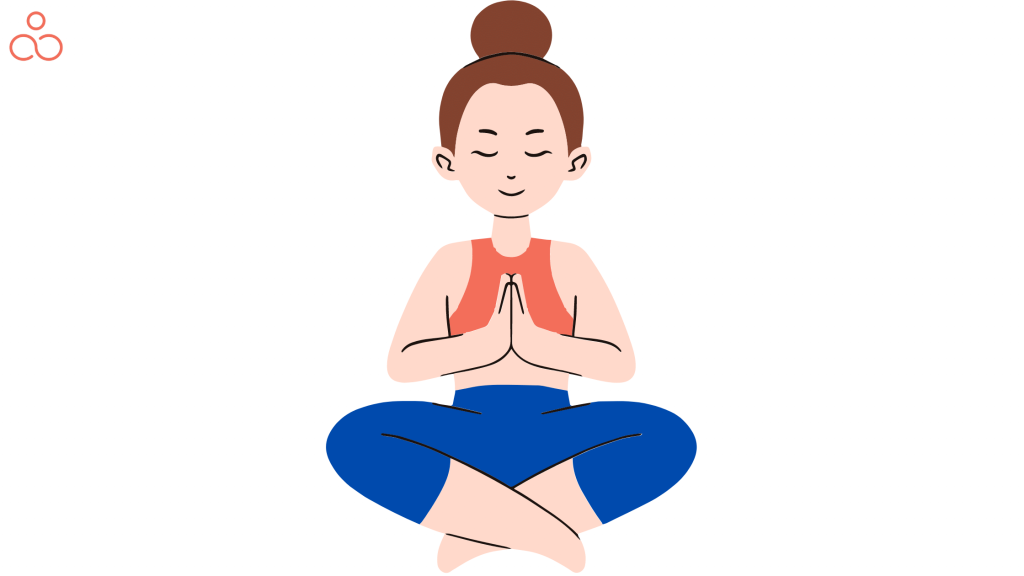Have you ever done Hot Yoga and felt sick right after or even in the middle of it? Even though Yoga is a centuries-old practice used for physical and spiritual cleansing and healing. It seems natural, then, that it can also make you sick. A growing body of research is finding evidence that prolonged, extreme yogic activity can lead to a phenomenon called “Hot Yoga sickness” or “Hot Yoga poisoning” – especially if you overdo it. But what is Hot Yoga sickness, what causes it, and how can you prevent it? This article will answer all those questions, so get ready to learn how can Hot Yoga make you sick and what to do if it happens.
What is Hot Yoga?
Hot Yoga is a form of Yoga that is performed in a room that is heated to a temperature of 105°F (40.6°C). This type of Yoga is designed to promote sweating, detoxification, and increased flexibility. There are many different types of Hot Yoga classes available, each with its own unique style and approach. Some popular forms of Hot Yoga include Bikram Yoga, Hot vinyasa Yoga, and Hot Power Yoga. If you’re interested in trying Hot Yoga, be sure to consult with a qualified instructor and follow all safety precautions to ensure a safe and effective practice.
Hot yoga is often advertised as a way to “detoxify” your body, but this isn’t actually true. According to Daria Long Gillespie, clinical assistant professor at the University of Tennessee and senior vice president of clinical strategy at ShareCare, “We metabolize toxins in our body via the liver and via the kidneys and via the intestines, not via what we sweat out.” The truth is, the body naturally eliminates toxins on its own, and sweat is simply composed of water and salt.
Some Health Benefits Of Hot Yoga

Hot Yoga has numerous health benefits to offer. Through regular practice of Hot Yoga, you can experience an array of advantages for both your mind and body.
1. Improved Flexibility
Hot Yoga takes advantage of the heated room to help loosen up stiff muscles and joints. This loosening up eventually leads to improved flexibility and range of motion. The high temperatures allow the body to stretch further and deeper, helping practitioners to achieve poses they may have thought were impossible.
A 2013 study conducted on Bikram yoga revealed that after 8 weeks of practice, participants reported increased flexibility in the lower back, shoulders, and hamstrings compared to the control group.
2. Increased Strength
Having to hold poses for extended periods of time in Hot Yoga helps to build strength in various muscle groups. The added resistance of the heated environment also helps muscles to grow and develop more quickly than in traditional Yoga practices.
3. Weight Loss
The heat from Hot Yoga can lead to increased metabolism and calorie burning, which can ultimately lead to weight loss over time. Additionally, the physical exertion required in Hot Yoga can help to burn additional calories and contribute to weight loss.
A 90-minute Bikram yoga class could burn as much as 460 calories for men and 330 calories for women, according to Colorado State University researchers.
4. Better Posture
Practicing Hot Yoga helps to improve the posture of the body. Through various poses and movements, the body becomes more aware of how it should hold itself properly. The heat also assists in this process by relaxing muscles and allowing the body to stretch more effectively.
5. Enhanced Breathing
The breathing techniques used in Hot Yoga helps to increase lung capacity and overall respiratory function. Additionally, controlled breathing patterns can help to calm the nervous system, which can be especially beneficial for individuals who struggle with anxiety or stress-related disorders.
This 2014 study revealed that even one session of hot yoga could get your heart rate up to the same level as if you were taking a brisk 3.5 mile per hour walk.
6. Detoxification
Hot Yoga can help to get rid of any unwanted toxins that have built up in your body. Increased perspiration helps to draw out impurities and boost circulation, which can make you feel better both physically and mentally.
7. Reduced Anxiety and Stress
Finally, the meditative and relaxation aspects of Hot Yoga can provide significant benefits for individuals who struggle with anxiety or stress. The combination of heat, breathing techniques, and mental focus can contribute to a sense of calm and tranquility, helping practitioners to reduce feelings of anxiety and stress.
Another 2018 study of adults who were stressed and physically inactive revealed that a 16-week program of hot yoga lowered their stress levels dramatically.
Some Health Risks of Hot Yoga

There are also some health risks associated with this type of exercise that you should be aware of to prevent any accidents/injuries:
1. Dehydration
One of the most common health risks associated with Hot Yoga is dehydration. During Hot Yoga, the body can lose approximately between 1 – 3 liters of sweat per hour, which can easily lead to dehydration if the body is not rehydrated correctly. Symptoms of dehydration include feeling weak, lightheadedness, dizziness, fatigue, rapid heart rate, and dark-colored urine.
2. Heat Exhaustion
Heat exhaustion is another common risk associated with Hot Yoga and can occur when the body isn’t able to cool itself throughout the Hot workout. Symptoms of heat exhaustion include dizziness, confusion, nausea, headaches, and fainting.
3. Muscle Cramps
Muscle cramps are a common side effect of Hot Yoga and can occur due to the combination of heat and strenuous activity. Symptoms include sudden and involuntary tightening of muscles, as well as sharp and intense pain.
4. Respiratory Problems
Hot Yoga can also cause respiratory problems, such as shortness of breath or difficulty in breathing. This is because the Hot and humid environment found in Hot Yoga studios can often cause the air.
5. Heat Stroke
Heat stroke is a more serious form of heat exhaustion and is caused by prolonged exposure to Hot conditions. Symptoms include fever, dehydration, confusion, nausea, and vomiting. If not treated immediately, heat stroke can result in serious medical complications, such as organ damage and death.
6. Fainting
Engaging in Hot Yoga poses in an environment that is too hot can cause the body’s blood vessels to widen in order to reduce body temperature. This can cause a significant drop in blood pressure leading to fainting. Symptoms of fainting include dizziness, weakness, blurred vision, shallow breathing, and feeling like going to sleep.
Hot Yoga vs Bikram Yoga: Is Bikram Yoga the same as Hot Yoga?
It’s important to remember that Bikram yoga and hot yoga are not the same. Even though they are practiced in a heated room, there are distinct differences between the two. For instance, Bikram yoga is typically hotter, sometimes much hotter, than hot yoga.
The differences are as follows:
| Parameter | Hot Yoga | Bikram Yoga |
| Founder | No specific founder | Founded by Bikram Choudhury in the 1970s |
| Postures | Include various poses and sequences | Composed of 26 Hatha yoga postures and two breathing exercises which must be done in a specific order |
| Duration | Typically 60 – 90 minutes | Strictly 90 minutes |
| Temperature | Typically around 80°F – 100°F | 105°F (40.5°C) with 40% humidity |
| Music | Usually accompanied by music and finished with a round of applause | No soundtracks, applause, or guidance from the instructor |
| Environment | Hot yoga can be done in low lighting, illuminated by candles, and on any kind of surface | Bikram yoga studios must be equipped with carpeted floors, mirrored walls on the front, and bright lighting |
Is It Common To Experience Nausea After My First Hot Yoga Class?

Feeling nauseated after a Hot Yoga class is perfectly normal, especially if it is your first time. Hot Yoga classes can be very intense and strain your body as you are stretching, moving, and breathing at a rapid pace. All of this, combined with the heat, can lead to a feeling of nausea.
Nausea can also be caused by low blood sugar, dehydration, or a reaction to heat. However, it is typically nothing to worry about. Your body may need time to adjust, and you may experience a variety of sensations, including lightheadedness, nausea, dizziness, sweating more than usual, and others.
Rather than pushing through sickness, it is better to slow down and take breaks. Try to stay hydrated during the class by drinking plenty of water, having snacks before and after the Yoga class, and focusing on your breath. You will soon learn how your body reacts to the heat and how you can effectively cool down and replenish.
*Important: If you continue to experience nausea during Hot Yoga classes, consult a medical professional.
The Physical Anatomy of Hot Yoga: Some Key Aspects Explained!
Yoga is an excellent way to promote holistic wellness, with its gentle practice that is designed to bring balance to practitioners. Classes generally include a series of postures and finish with a meditative session, helping to improve flexibility, strength, and mindfulness.
Some key aspects of Hot Yoga anatomy include:
1. The Squeeze And Soak Technique
B.K.S. Iyengar’s famous “squeeze and soak” theory proposed that when you perform twists and bends, your spine squeezes and soaks the abdominal organs, including the liver, kidneys, and intestines.
When you release the twist, circulation is improved and nutrients rush back to the affected areas. This is why twists and bends are beneficial, as they aid the body’s natural detoxing organs. After a twist or bend, some may feel sick as the blood returns to the area.
Your instructor should always ensure that twists are done on both sides, and that bends are followed by a movement or pose that reaches upwards. This balance helps the body readjust and minimizes any feelings of sickness or discomfort.
2. The Lymphatic System
Yoga is an excellent way to mobilize and rid your body of toxins via the lymphatic system. This system doesn’t have a pump, so it relies on physical activity and motion to remove excessive metabolic materials, fluids, and impurities from the body.
Yoga is the perfect practice for a healthy lymphatic system – it combines asanas, mindfulness, and breathwork in a way that gets your body moving and toxins released. Though, this can lead to some discomfort if you’re not used to it; however, the more you practice, the better you’ll feel. If you’re feeling unwell during a yoga session, take a few minutes to rest in the child’s pose before continuing.
Here are some poses that you can do for optimal lymphatic health:
- Supported child’s pose (Balasana)
- Supported plow pose (Halasana)
- Supported downward-facing dog post (Adhomikhasvasanasana)
- Adept’s pose (Siddhasana)
- Supported bridge pose (Setu Bandha Sarvangasana)
3. The Psyche Works Through Emotions
Yoga students often experience intense emotion while on the mat. Because the yoga studio is a safe place for self-reflection, old wounds may arise and make you feel uncomfortable or even physically ill.
The best course of action is to accept the emotions and go with the flow. Don’t try to bottle up your feelings; it’s beneficial to express yourself in a healthy way.
4. Circulatory System
Similar to the point above, asanas can give your circulation a boost. When your organs start receiving increased blood flow where it usually doesn’t travel, you may experience some discomfort as a result.
How Can Hot Yoga Make You Sick?

Hot Yoga has become increasingly popular amongst exercisers as a means of achieving increased flexibility, better posture, and improved relaxation. What many don’t realize is that Hot Yoga can have significant drawbacks if not practiced properly. The combination of increased heat, increased intensity, and lack of hydration can all lead to potential health problems. Heat stroke, dehydration, and breathing issues can all be exacerbated by Hot Yoga, leading to serious medical problems.
1. There are certain signs and symptoms that can be experienced when individuals participate in Hot Yoga. These include:
- Chills and sweating
- Nausea
- Vertigo
- Light-headedness and dizziness
- Headaches
- Fatigue & Muscle cramps
- Difficulty focusing
It is believed that extreme heat can overwhelm the body, leading to an uncomfortable situation that can ultimately result in sickness. Heat stroke is one of the most common problems associated with Hot Yoga. Due to the heat created by the classroom and your own body heat, temperatures can quickly get to dangerous levels. This can lead to severe dehydration, nausea, worsening of pre-existing breathing issues, dizziness, and even fainting.
2. The profuse sweating that comes with hot yoga is a problem. It prevents your body from regulating its temperature in its usual way. Your body is normally good at keeping you from getting too hot or too cold, but hot yoga gets in the way. As Noah Greenspan, a cardiovascular and pulmonary physical therapist in New York City explains: Typically, your body sweats to [control temperature], and when cool air hits you, your body cools off. However, because the room temperature is so hot, you don’t have much of an opportunity to release the heat.
Due to this, you sweat more and more, leading to potential dehydration. According to Loren Fishman, assistant clinical professor at New York Presbyterian Hospital, Columbia University, 50% of hot yoga participants have been found to be dehydrated. It may not seem like a big deal, but dehydration can be extremely hazardous.
3. Intense exercise without proper technique can be hazardous in a Hot Yoga class. Since the heat contributes to an already high intensity, it’s easy to push yourself too hard and become fatigued more quickly than usual. While it’s ok to push yourself, it’s vital to ensure that your form is correct and you’re not overextending yourself. Overtraining can lead to more severe health complications and increase your chances of injury.
The Causes & Remedies of Post-Hot Yoga Sickness
If you’re not feeling great after a yoga session, there could be a few explanations. These might include:
1. Inadequate hydration
Solution: Replenish your body with water before, during, and after your yoga practice. This is especially important in hot yoga sessions, where you’ll be losing a lot of moisture through sweat. Throw in some hydration mix to your water to help keep dehydration at bay.
2. Eating too much or not enough before your session
Solution: Before your yoga class, eat a nutritious protein snack, like an apple, some nuts, or a protein bar. Avoid fatty meats and dairy, which take longer to digest and can cause discomfort as you practice. If you’re planning to eat a full meal, make sure to give yourself 2-3 hours before your yoga session.
If you want to know more about the right foods to eat before Hot Yoga, check out this article.
3. Exposure to high temperatures
Solution: If you feel like limits are being pushed too far, it’s best to take a break. Step outside and get some fresh air. Don’t push your body too hard and put yourself at risk of heat exhaustion or heat stroke.
4. The liver or Gallbladder is full of toxins
Solution: Let the toxins go. If you experience serious discomfort, it’s best to seek medical attention and not ignore this advice. However, it’s quite likely that a bit of feeling under the weather simply indicates that your body is expelling toxins that it never has before. If your symptoms don’t pass within two days, it’s best to seek medical guidance.
5. Emotional trauma being released
Solution: This could mean your instructor is being a bit too demanding or causing tension for the sake of ‘perfection,’ reigniting childhood feelings of inadequacy. To address this, you may need:
- Opt for a gentler approach.
- Find a yoga instructor experienced in working with people who have experienced trauma or may have PTSD.
- Face the traumas head-on. Let your body feel and release the emotions buried deep within you.
Can Hot Yoga make you feel sick from detoxing?
Hot Yoga can indeed make you feel sick from detoxing. Detoxing is a process where the body expels toxins out of our system, either through the skin, lungs, or kidneys. Hot Yoga speeds up this process, which can be overwhelming to the body, leading to nausea, dizziness, and feeling overheated. Additionally, elevated heart rate and respiration can lead to lightheadedness or dizziness. However, some people may be extra sensitive to the intensity of Hot Yoga and, therefore, more commonly suffer from detox-related symptoms.
To avoid this:
- Begin a detox session – Make sure to drink plenty of water and take breaks whenever needed.
- Drink detox tea – It can be beneficial for you as it contains certain herbs and minerals known to help flush toxins.
- Taking Epsom salt baths and consuming vegetables and ginger are other effective ways to support your body during the detoxification process.
Who Are Most At Risk for Hot Yoga Sickness?
According to research, certain populations are more vulnerable to Hot Yoga sickness. These populations include:
- Individuals with pre-existing conditions such as asthma, heart conditions, or diabetes.
- For those who are older, age can impact how the body adjusts to temperatures.
- Those with low fitness levels or who are out of shape.
- Pregnant women who are pregnant or have recently given birth.
- New or inexperienced Hot Yoga practitioners.
By being aware of the potential risks of Hot Yoga and taking the necessary precautions, individuals can practice this type of exercise safely and enjoy the many benefits it provides.
How Can You Avoid Sickness and Nausea During & After Hot Yoga Practice: Extra Safety Tips!

Fortunately, there are multiple things you can do to help minimize the risk of getting sick and feeling nauseated.
Here are some bonus safety tips:
1. Take rests and breaks
Make sure to take rests and breaks throughout your practice. This will help keep your body from overworking itself and prevent you from getting sick.
2. Warm-Up Before Class
Pay particular attention to your warmup before class. Make sure to take your time stretching and use long flowing motions. This will help prepare your body for the temperature changes that occur during Hot Yoga.
3. Move at your own pace
Depending on your fitness level and the intensity of the class, be sure to move at your own pace and at your own comfort level. Always listen to your body, and do not overdo or push yourself too hard to avoid injury.
3. Avoid Hot Yoga if you’re pregnant
If you’re pregnant, it is not recommended that you practice Hot Yoga. This practice can put too much strain on your body and can be dangerous for you and your baby.
4. Wear proper clothing
Wear materials that are loose and stretchy to help keep your skin dry and limit sweating. Cotton is a great option since it absorbs moisture and is breathable. Avoid wearing fabrics that are tight and fit too close to the body.
5. Bring a towel
Be sure to bring a sweat-absorbing towel to practice Hot Yoga, as you will be sweating a lot during the session.
6. Use a non-slip Yoga mat
Invest in a good, non-slip Yoga mat that will provide you with the right traction and grip in order to practice Hot Yoga safely.
7. Avoid caffeine
Caffeine can make you jittery, which will make your practice more difficult. Avoid drinking caffeinated beverages before and after your practice.
Frequently Asked Questions
Can Hot Yoga Make You Sick?
Yes, Hot Yoga can make you sick. Heat can exacerbate pre-existing health issues or lead to potentially dangerous conditions, such as dehydration, heat exhaustion, heat stroke, and even hyperthermia. If you are already ill or your sweat does not evaporate quickly, you can become overheated, dehydrated, and even pass out.
Can Hot Yoga Make You Sick Because Sweating Out Excessively?
Yes, Hot Yoga can make you sick because excessive sweating can deplete your body of electrolytes, and cause dehydration or a heat injury, leading to fatigue or dizziness. Additionally, most Hot Yoga classes are held in enclosed spaces, which can create stagnant air and make it more challenging for your body to eliminate toxins from your body.
How to avoid Hot Yoga sickness?
To avoid Hot Yoga sickness, it is important to stay hydrated and take regular breaks. You should also practice proper breathing techniques, such as deep breathing and focusing on slow exhales, in order to avoid overstretching and staying cool. Lastly, if you feel dizzy or nauseous, take a break and drink plenty of water to rehydrate.
Conclusion
Yes, Hot Yoga can indeed make you sick sometimes; however, this usually happens when you push yourself too hard or sweat out excessively. If you are careful, detoxing with Hot Yoga can be an impressive way to improve your health and well-being. Finally, stay hydrated and take regular breaks while doing Hot Yoga. This way, you can ensure that you are taking care of your body while also getting the benefits of Yoga. Remember that health should always come first and is worth considering before taking on any new physical activity.
So if you’re considering giving Hot Yoga a go, keep these tips in mind, and you should get the most out of your workout – healthily and happily.

